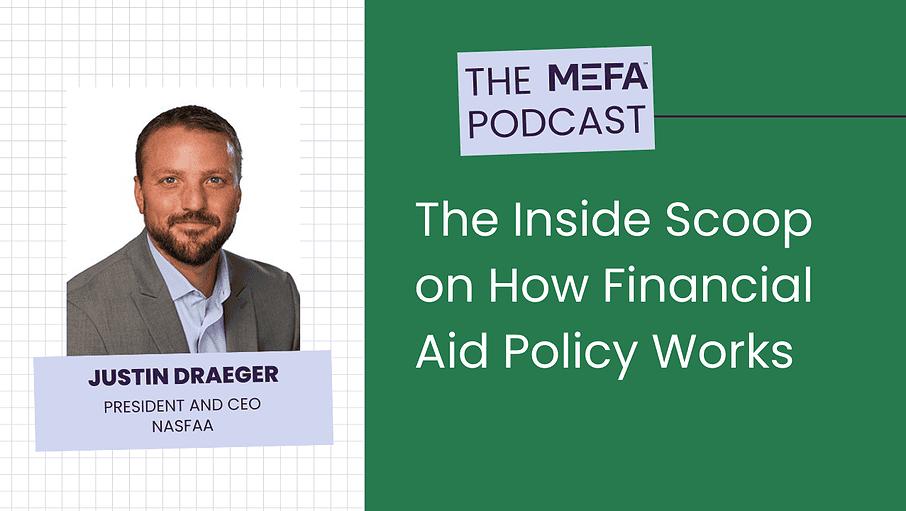

Resources Mentioned in this Episode
Jonathan Hughes: [00:00:00] Hello, everyone, and welcome to the MEFA podcast. My name is Jonathan Hughes.
Julie Shields-Rutyna: And I’m Julie Shields-Rutyna.
Jonathan Hughes: And oh, what a great show we have today. It’s a special show, as I called it on the interview, our Schoolhouse Rock episode. How does financial aid policy get set in Washington? If you’ve ever wanted to know how things like how the FAFSA gets designed or who design, who decides how much students can borrow or getting a federal grant.
Well, Justin Draeger, president of the National Association of Student Financial Aid Administrators, or NASFAA, is the guy who knows. And we talked all about it, and you’re going to hear about it in about five minutes. In fact, this show is so special that it would normally be one of those shows that we just cut straight to [00:01:00] it, but honestly…
I didn’t want to do another show without Julie Shields-Rutyna. I think the people have had enough of it. They’ve had enough of no Julie episodes. I have, I know. So, what I what I want to do first is do a mailbag question with Julie. And then we’ll get right into that great interview with Justin. So how does that sound, Julie?
Julie Shields-Rutyna: I’m honored. That’s all I’ll say. Thank you for saying that. Very nice. I’m happy to be here. So that’s good.
Jonathan Hughes: Of course, of course well, since it’s a mailbag question, I’ll have to just say, I’ll remember if you have any questions, you can email us at [email protected]. You can call us at 1-800-449-MEFA and you can reach us on social media.
Which is Facebook @MEFAMa, on X at @MEFATweets, at Instagram, @MEFA_MA. So this week’s question comes to us. From Kelly who writes, and this, this one kind of begins in medias res. So if you’re, if you feel like you’re right in the middle of things, this is how it was written. She says, so parents will no longer be able to manually input their [00:02:00] income taxes information line by line, question mark, question mark.
So she’s asking us in the new FAFSA, if she understands this correctly. First question there, because retirement rollovers are not picked up correctly on the FAFSA form and automatically populated from the IRS and cause a major income error every time because it lists the dollar amount of the withdrawal rather than the rollover status, which does not count as any income because it’s a rollover. and zero to income. Julie, you’re going to have to translate this for me after I’m finished. And a nightmare to fix with schools to change to zero for a retirement rollover and takes forever and wastes time. I’m picking up on some frustration here. Please advise. Thanks. So Julie, what can you tell me? What is this question really asking and what is the answer to it?
Julie Shields-Rutyna: Yes. Well, I, this is a person who knows what Here she is doing and knows, knows about financial aid. And so, but I can see that might [00:03:00] come from past applications where some things didn’t go right or whatever, but anyway so this person is correct in that. The new FAFSA is going to make it so that most information, and this is a good thing, most income information is going to roll right into the FAFSA from the tax return.
And that is a win for everyone. However, this issue that she worries about is going to be taken care of. And that’s because even though most of the information is going to roll in, there is a question that is going to ask if there was a rollover, and if so, it’s going to ask the family to manually enter the amount of the rollover so that the IRA distribution is not included in the income for the family.
So it’s take- it’s taken care of, and it’s specifically, and it’s one of only a couple of, [00:04:00] questions that families are going to be able to enter manually. And so, this should actually make it easier for her in the future, and I hope so.
Jonathan Hughes: So I’m glad that was such an easy answer to such a confounding question. So, one more time. If you have any questions, you can email us at [email protected]. You can call us at 1-800-449-MEFA. Our Facebook is @MEFAMa, X @MEFATweets, Instagram at @MEFA_MA. And just to remember, everybody in this season of FAFSA uncertainty and CSS Profile® questions, we have a bench of college guidance experts waiting to answer your question.
So now let’s go to my conversation with NASFAA president, Justin Draeger to learn how the financial aid sausage gets made. We’re in the Fall and that means that a lot of what we’re doing these days at MEFA and at our friends at partner organizations as well is explaining financial aid to families, and so the various grants and [00:05:00] loan programs that exist and their details and who gets them and why and what they cover, among other things, but why are the answers to those questions what they are, and why is this amount that students can borrow, the amount that students can borrow every year, or who gets what in a grant and what’s that amount, who decides these questions, and so how the are those decisions made?
Well, to tell us all about this on the show today is Justin Draeger. Justin is the president and CEO of the National Association of Student Financial Aid Administrators. He serves as liaison between that group NASFAA and the U S Congress. Other federal agencies and the media. And he’s a great person to talk to about this because since 2002, he’s been engaged in either administering, interpreting, communicating, or developing student financial aid policy. He’s been a financial aid director, policy analyst, [00:06:00] spokesperson, and has held senior positions, overseeing government relations, communications, and policy work. It’s also testified before Congress on student financial aid, college access, student loan policy, among other topics, and has appeared in the media in places like the today show, national public radio, box, business, news, CNBC.
So that’s a lot. I know, but I know him as the host of NAFSAA’s Off the Cuff Podcast, which is a great podcast. Justin Draeger. Welcome to the MEFA Podcast.
Justin Draeger: Really glad to be here. Thanks for having me.
Jonathan Hughes: No, it’s our pleasure. So, tell the folks who maybe are not aware of NASFAA, what NASFAA is and so what it does and what you do as the president.
Justin Draeger: Yeah, thanks. We’re a member association. So, we have members, and they join NASFAA from all over the United States. We specifically represent financial aid offices at 3000 colleges and universities and career schools. Our members serve nine out of [00:07:00] 10 students enrolled in post-secondary education across the country.
So very broad membership and our mission is to help them with professional development and training so that they stay on the right side of federal regulations and rules of which there are many to advocate on their behalf and on behalf of their students on federal student aid regulations and really to advocate on student aid issues so that there is money to help students afford and succeed in post-secondary education. So that’s what we’re about.
Jonathan Hughes: And how long have you been president?
Justin Draeger: I’ve been president since 2010. So, this is my 13th year.
Jonathan Hughes: Wow. Wow. That’s impressive.
Justin Draeger: Yeah. It’s sort of interesting because in 13 years, we’ve seen pretty significant changes in the federal student aid programs. But we haven’t actually seen a reauthorization of the Higher Education Act.
That’s the legislation that oversees all of our programs. And it sort of marks a new way that we approach [00:08:00] rules and legislation on federal student aid. So lots of changes, but none of them the way that Congress originally intended for these changes to be made. And it’s, it’s made things sort of interesting for colleges that have to implement all of them. It’s also made them really interesting for families that are trying to navigate really complex ways that we in this country finance higher education.
Jonathan Hughes: We’re going to talk about that specifically. So I’m glad that you brought it up before. When you just kind of touched on it but as I mentioned, you know, we spend all of our time really walking through with families, the financial aid process. And I use the examples of explaining federal direct loan limits. And you know, the features associated with the federal direct loans, but we don’t really talk about the, the why or the how. So tell me and everybody listening, and as you just sort of referred to, how does that all of that happen?
Justin Draeger: Yeah, it’s so it [00:09:00] sometimes can be really opaque especially to students and families, because oftentimes, you know, the people that they’re working with are the financial aid offices on campus.
And it’s really easy to assume that these really complex, sometimes misunderstood or arcane rules. Are like the result of financial aid offices. Like, they’re the ones who came up with it. And sometimes financial aid offices are the ones that take the brunt of the frustration, understandably. Like families don’t understand why the rules are this way or that way.
And there are like, lots of examples of this. But the bottom line is that ultimately the way it works is Congress, when it comes to federal funding at least, and then there are other examples of this at the state level or institutional level or local level, but Congress comes up with laws. Laws are generally broad.
They authorize the creation of programs. There’s a separate process in Congress that funds programs. So you can have the creation of programs that are funded at totally [00:10:00] different levels. Year by year, and from there, if we go back to, like Civics 101 then administrations, different administrations. So right now we have the Biden Harris administration before that was the Trump administration before that was the Obama, but different administrations come in and they regulate and regulations are where laws are turned into actual rules that have to be implemented. So between like what Congress conceives of and regulations that implement and then the aid offices that actually have to turn them into something actionable for students and families, a lot can happen and a lot does happen. And you combine that with like the fact that we have like Federal programs and we have state programs and local programs and private scholarship providers and institutional aid and in this country, we just have like a real patchwork of ways that we fund higher education. It’s complex and students and families really feel that complexity [00:11:00] when they have to try to piece all this together.
Jonathan Hughes: Do you have an example at the ready of something that, you know, because you just gave a great example of the Congress comes up with the. The laws and then when it comes time to actually, or the policy, when it comes time to actually implement them, this is where I’m imagining that NASFA really is helping with this process of turning something that has been shepherded into an actual reality. You can tell me if I’m right or wrong about that. But you know, do you have any examples of some of the details? Maybe that may have to work out or some things that are different between the way that somebody may think of. A policy and how it’s actually implemented.
Justin Draeger: I’ll give you one from the past and then we can talk about maybe a current one. So in the past, Congress thought up an idea of, you know, historically Pell grants, you could only get one year’s worth of Pell grant in a single academic year. Which makes sense, you know, in one academic year, starting in July and running through June, you can get one Pell [00:12:00] Grant. But some students like to accelerate their programs, they want to go all year round. And they might, if they use their Pell Grant in the fall and winter terms, then they wouldn’t have access to another Pell Grant in the spring or summer. So Congress, hearing from constituents and advocates like NASFA decided that they would give Pell Grants year round.
So if students wanted to attend year round, they could have access to more Pell Grants. And then they would place like a lifetime limit on the whole number of Pell Grants you could get. This is a great idea in concept, because why would we hold people back? Like, yeah, go ahead, accelerate your program, get out sooner, get a job sooner.
And then when it got to the rulemaking process, the Department of Education came up originally with a really convoluted Way that schools had to calculate these year round Pell grants between different award years based on these really technical calculations based on when Congress funded one year versus [00:13:00] another year.
And if there were these really minute differences. in calculations, schools would have to like retroactively go back, refund one year’s worth of Pell Grants, and then issue a new Pell Grant. And then you multiply that by, you know, six or seven million. I’m overstating this a little bit, but lots of students.
Doing this by hand at an institution and you take a great concept and you basically ruin it in a rulemaking process. And so you take advocates of this colleges who advocated for this and you turn them against the very idea that they originally were proponents of. So ultimately the rulemaking process went sideways.
The Department of Education at the time thought they were doing something that was like going to be in the best interest of students. It ended up being really bureaucratic, really burdensome. It was rolled back, reintroduced by Congress that got really [00:14:00] specific about how the department could regulate it in the future, and basically said schools will determine which year it’s paid out of.
The Department of Ed can no longer do that. Like, they, they created too many rules around this. And now we have it back. And it’s better. So that’s a example from the past where something went sideways because, you know, bureaucratic rulemaking went went off the rails right now. A more modern example. I think everybody probably in higher ed and maybe students and parents are probably also learning.
That we’ve had a law that’s changing the FAFSA and underneath the FAFSA is federal methodology. The form follows the formula and schools and the Department of Education aren’t doing this through rulemaking, but they are underneath working together to try to create this whole new FAFSA form and this new federal methodology that should be out hopefully in the month of December.
That will [00:15:00] impact Pell distribution will impact how students and families are awarded financial aid. This is the biggest undertaking in two decades. So yeah, this, this starts at the congressional level and then goes all the way down to the implementation level happens over and over and over again.
Jonathan Hughes: Talking about something that you mentioned earlier, which is reauthorization. Can you tell a little bit more about what authorization is and how historically it should work and. Why it hasn’t been happening and maybe what the impact of that has been.
Justin Draeger: Yeah. So the way it used to work is the higher education act was first signed in 1965. And then in 1965, the idea is, and this happens with all federal programs in theory, you create Congress creates legislation, it’s signed by the president. It authorizes or creates programs. And the idea is that Congress always then sets expiration dates on those programs so that they will be revisited in the future by a [00:16:00] future Congress, who is supposed to evaluate, like, The programs effectiveness and then tweak the programs or cancel the programs or maybe create new programs.
Higher Education Act was no different. So when it was first signed into law it created various programs and then they are set to expire. So in 1965, we had the Higher Education Act and then it, that, that legislation was reauthorized with changes. in 1968, 1972, 76, 80 86, 92, 98 and you could see that it was happening every four to six years.
We would reauthorize the programs with changes. And the nice thing about that process is, is that every time you reauthorize that legislation, it’s very transparent. There are hearings. You work with the over the committees that oversee that legislation. In this case, it’s the Senate and, and house education committees.
Very slightly different names, but basically education committees. In [00:17:00] 1998, things started to slow down a little bit, so between 1998 and the next reauthorization didn’t happen in 2008, so a 10 year gap. And we haven’t had a reauthorization since 2008. So now we’re on. You know, we’re on, I guess, 15, almost 16 years.
Jonathan Hughes: Why haven’t we had an authorization since 2000?
Justin Draeger: That sort of betrays the partisanship and just the brokenness of Washington, D. C. I mean, you can sort of trace this back to probably back to the Obama years where we started to see this split between the Republican Congress and President Obama.
And I’m not pointing fingers here. That’s, I’m not here to, you know, NASFAA is a nonpartisan organization. And I, I mean that sincerely not tongue in cheek, but. The Obama administration made the determination that they couldn’t get something done with the Republican Congress. So this was like the exact opposite of like the Clinton [00:18:00] administration.
And when Newt Gingrich came in with the new, the contract for America with the Republican Congress, where. They actually had a very productive season. This sort of fell apart in 2012. John Boehner was speaker at the time and they, they were just polar opposites. We started to also see a real fracturing within the Republican party and the Republican conference, I don’t think has really ever recovered from that fracturing. So bottom line is. The Obama administration made a decision that they were going to start regulating without legislation. And it’s not like there’s no precedent for that, but I think what was unprecedented was that they started regulating at a really rapid pace without any legislation.
So you saw things like them regulating gainful employment, defining gainful employment, which. You know, created hundreds, of pages of sub regulatory guidance and new regulations, all without any legislation at all. And ever [00:19:00] since then legislation has been done piecemeal, attached to budget bills, because those are the only real legislative bills that get done anymore.
They’re done very opaquely, they move really quickly. And both the Democratic and Republican administrations, so the Obama administration, the Trump administration, and now the Biden administration, they issue regulations at a very fast pace every single year. And when legislation comes, it can be really big and it moves really fast.
And what that ultimately means for aid offices and schools is it’s unpredictable. It’s really fast. It’s really complex. And for families, it’s the same. It’s changes come every year and they move really quickly.
Jonathan Hughes: Do you think that there have been fewer changes than we would have expected or more change, more comprehensive change or less comprehensive change than we could have expected with the [00:20:00] authorization process?
Justin Draeger: So I think that with reauthorization, you would expect to see more comprehensive change and more orderly change. So, what happens is, in a reauthorization, they would reauthorize programs, it would be done usually very openly, and then Congress would say, the Secretary of Education shall promulgate regulations on this, that, and, you know, X, Y, and Z.
Now what we’ve had since 2008 is, you know, several big changes. Like in 2010, we had the elimination of the federal family education loan program. So bank based lending that was done attached to a budget bill, budget reconciliation bill. In 2017, we had the restoration of year round Pell grants. Which I talked about earlier that was done attached to a budget bill, the future act, which attaches the IRS and department of education data sharing that was done through a budget bill.
And then the FAFSA simplification act, which makes all these [00:21:00] changes to the federal formula and the FAFSA was also done through a budget bill. All of these big changes in the last 10 years have, or 13 years, have all been done through budget bills of some sort. They’re big, but in some ways they’re, they’re not as comprehensive.
They’re not like I guess they’re not as comprehensive as a reauthorization, but they are still really big bills. They’re big changes. And they’re having a big impact. And then besides all that, so you take all of that, put it here on top of all that, the department of educations under both the Obama Trump and Biden administrations.
have just done an enormous amount of regulating. Some of it’s like undoing what the last administration done or redoing, like gainful employment has been re regulated like three or four times at this point.
Jonathan Hughes: Yeah. Can you talk about that a little bit? Because, and I know it’s complicated. I don’t want to get too much in the weeds of gainful employment, but it’s something that I think people would hear people like myself and go, what [00:22:00] is that again?
Justin Draeger: So, right. So in the law, there’s a, basically in the statute, the higher education act, it just says that Non degree programs and programs at for profit or proprietary institutions must lead to gainful employment. And then in 2011, the Obama administration decided that they were going to define gainful employment, what that meant in regulation.
And the rule then applied to non degree programs, which are like certificate programs and public and nonprofit programs. And then nearly all programs offered by for profit schools. It was challenged in court by proprietary schools. And it was never implemented because of legal challenges that was back in 2011.
And then in 2015, the Obama administration issued a new gainful employment rule that would pass muster with the courts. So challenged again, but was, was slated to take effect in 2019, except the Trump administration came in and[00:23:00] renegotiated it and opted to rescind all of the Obama era regulations related to gainful employment, then the Trump administration lost reelection and the Biden administration came in and in 2022, you know, just a few weeks ago, reissued new gainful employment regulations that are scheduled to go into effect in 2024. So this is just an example of like the swing of back and forth on one set of regulations around, you know, massive that basically measure whether certain programs lead to gainful employment by looking at debt to income ratios.
On student loan debt in certain programs and income outcomes, like whether, which in concept again are like, these are fine things, but for an implementation purposes for schools, they are on like a real merry go round on massive changes. on program reporting and accountability metrics.
Jonathan Hughes: It seems all of a piece of [00:24:00] sort of things in general, right? It sort of seems like this might be illustrative of the past, the past few years.
Justin Draeger: I think what you’re seeing is like, things done through regulation will always swing back and forth. Things that are done in statute tend to stick around. And I think that’s what we’re seeing without, without statutory changes, we’re going to see these wild changes back and forth because they’re being done by administrations and the American public vote in different administrations.
When we have things done in statute and in law, you don’t see these wild swings. So Congress just, whether you see it as a feature or a bug of the American constitution, Congress doesn’t come in. And do these sorts of things. They kind of come in, they make changes, they make changes slowly. They see how things work out.
But when it comes to administrations anymore, they regulate, rescind what the last administrator, they regulate back and forth all the time. And that, that just creates a lot of expense and, and chaos for institutions.
Jonathan Hughes: So, [00:25:00] moving from that to FAFSA simplification are you, well, I wouldn’t say surprised because given what you just told me it makes sense the way it happened, but FAFSA simplification as you mentioned is the biggest thing to happen in a few decades to financial aid. So when I first heard about it, I was surprised that such a substantial change had occurred in this non reauthorization environment. Hearing you talk about it now, shed a little light on, on it, essentially, how did this happen and where you, what was your reaction to it?
Justin Draeger: In I’m trying to remember the exact year, but it was probably 2014 or 15. I mean, Senator Lamar Alexander, who’s now retired from the Senate from he was the different times chairman or ranking member of the Senate education, Senate health, education, labor, pensions committee, or basically the committee that oversees the student aid programs in the Senate side, he had been talking about FAFSA simplification for a number of years, and he, we invited him to come to a NASFA conference.
And he had been hearing a lot of support for [00:26:00] simplifying the FAFSA from different constituencies. So when he came to NASFAA, we had a sense that he might get a different story because the FAFSA back in the 90s was supposed to be the unifying form prior to the FAFSA, you know, schools, states, the federal government, private scholarship providers were all using different application forms.
So students were using having to fill out multiple applications. And, and I don’t want to overpaint this. Like, obviously some, you know, people still had different forms, but the FAFSA really was the unified form. And the idea was to try to get as many funders in higher education to use the FAFSA as possible, which is why it was sometimes complicated and why it asked so many questions.
It was the federal methodology that, that everybody was trying to use. Not everybody did. We were trying to use. So the FAFSA came about in the, in the mid to late nineties. And then Senator Alexander and several advocates started [00:27:00] using data to show that, look, for most FAFSA applicants, you could still get the same exact or close to the same outcome by asking far fewer questions.
And so Senator Alexander then started asking, well, why do we ask so many questions of so many applicants, especially when we have so much technology? That would allow us to skip by a lot of these questions. So he came to the NASFA conference. We had, you know, 2,500 people at our conference. He came to a general session and he was, as he was want to do, he sort of unfurled the FAFSA, the paper FAFSA.
Now, granted at this time, not a lot of people fill out a paper FAFSA, right? And it was sort of the wrong crowd to do that in front of, because our members like 99 point. 8 percent of people fill FAFSAs out online, so it didn’t like get off on the right foot from the get go and. He did his thing and to Senator Alexander’s credit, because I asked [00:28:00] him, you know, I said, Senator Alexander, do you want me to moderate the questions?
Because I sort of said, I think you might get a little pushback here. And he said. He said, no, he said, you know, Justin, I can handle it. And he stood up there and he took, he took the feedback and the feedback from our members at that conference was, ‘ because he was saying like, I think we can get the FAFSA down to like a postcard or something like that.
And the feedback from our members was, that’s not going to work. And if you do that. All institutions are going to start introducing their own application not to mention states. So Senator Alexander, after that session came back to us, he held a hearing, he invited us to the hearing and he said, okay, we can’t get it to a postcard, but how can we do it?
And our response to him was for some students, you don’t need to ask anything other than their demographic questions. Let’s just link to the IRS. Or if they’re on federal means tested benefits, like we know they’re low income, that’s all we need to know. We don’t need anything else from them for other families.
If their financials are a little more complicated, [00:29:00] let’s import most of their information from the IRS and then just ask them a few more questions. So to your question about like, how much was NASA involved? We were involved a lot and Senator Alexander, to his credit checked in with us a lot. Now remember, you know, we talked earlier about the process.
Now, if this was a reauthorization, this would have been very like transparent all the way through. But because this was going to be attached to a budget bill Senator Alexander and his staff came to the NASFAA board and asked for our support because we had worked on this so extensively. The NASFAA board voted to support The FAFSA Simplification Act.
So we went in and supported the bill. It’s not the exact bill we would have written. Okay, but we’re not, we’re not elected lawmakers. And you’re never going to get 100 percent of what you want. But it was mostly there. Now this is where it starts to get a little wonky because then it goes behind closed doors.
It gets attached to a budget bill. And you don’t always get to see the last minute changes that might get made to a bill. Because [00:30:00] it just, it’s now it’s attached to like the one train that’s leaving the station that year. And it’s going to be a budget bill and all lawmakers, if they want to get anything passed are throwing their legislation at that train because it’s the only train leaving the legislative station.
So there were, there were like a few things attached to that bill. We didn’t know we’re going to be attached to it. Like changes the cost of attendance. We didn’t know about that until, until the very last minute. And at that point you can’t. You can’t make changes to the bill. So I guess I would say like we supported it. We were consulted, but we didn’t know everything that was going to be in that. Until the very end.
Jonathan Hughes: Well, the way you described it up until that, that point of the variant, it almost seems in spirit, very similar to the reauthorization process that, you know had a buy in and you had give and take from, from the center and you were consulted and, and, you know, there was a comment process or what have you until that point, does it ever happen where you’re just totally sort of like, Oh, [00:31:00] this is happening now. And you have to sort of react to it.
Justin Draeger: Yeah. So I think the way you describe it is fair. I would also just add that no matter what bill you pass, You almost always are going to need technical amendments later. Like, there are things you don’t think about. None of this gets at what the department’s going to do on the other side of it.
Like, Department of Ed folks and Department of Ed lawyers touch things, and like, sometimes they do things you don’t anticipate. So, there’s always that. And are there bills that come up that we don’t anticipate? Yes, but not very frequently. I would say that and that’s just the virtue of like getting plugged in and making sure that you have a wide expanse, and this is where it really pays for advocacy.
You know, where NASFA members can really get involved. NASFAA has a pretty extensive network on the Hill when it comes to working with lawmakers who are really plugged into the education space. We have a pretty wide net. We certainly are plugged into the education committees. And the congressmen and [00:32:00] women and senators who sit on those committees, but where NASFA members can really get involved and have an impact or anybody really is on their local representatives and state senator.
I mean they’re senators from their state. They all love their local constituents and colleges, and if there’s an issue that they want to talk about with their local representatives, I mean, that’s where they can have an impact and they might not even sit on the education committees, but that’s where we sort of lean on our members.
And we let NASFAA flies members in from our membership most months out of the year, and we just go visit their representatives or senators to connect them. So, like, if legislation’s coming up, they’ll think, oh, I actually know an aid administrator in my own district who I should maybe check in with before I just, you know, sign off on a bill or, or think about some legislation in some area that a constituents talked to me about. So that, that’s where people can have a real impact.
Jonathan Hughes: I know there’s a million things going on. I wrote these questions a few weeks ago, which was a different [00:33:00] world when it comes to the Congress and will probably be a different world in a few weeks from now.
But you know, I know there’s a lot with FASFA simplification and new repayment plans and everything like that. But what are some of the things that are being discussed in various conferences and chambers right now that we can look forward to hearing about?
Justin Draeger: I would look at it more like thematic things that, that Congress is talking about. And what’s interesting is I’ve been in closed door meetings with Republicans and, and Democrats, and thematically, they’re not really talking about different things. Now, some of the solutions might be different. But the themes are the same. So they’re talking about affordability. They talk about constituents who can’t afford a post secondary education.
They’re talking about the value of a post secondary education and student loan debt in that equation. So how student loan debt and accumulating debt can actually cut into the value of a degree. Talking about the [00:34:00] value of a short term credential and how that is can be an alternative to a 4 year degree or a master’s program.
They’re talking about accountability for colleges and universities like them having maybe more skin in the game, particularly on the Republican side. They would like to see colleges have more skin on the, in the game for the students who are taking on loan debt and not paying it back. But on the Democratic side, they’re also talking about more accountability for colleges and universities.
Albeit in a slightly different way, and everybody’s talking about more transparency. more transparency about student outcomes, giving students and families more information about how much programs cost and their prospects for employment after they graduate. And I think that all gets at, like, the same thing, which is there is like a public confidence issue.
In this country around like all institutions and higher ed has not been insulated from that. [00:35:00] There are, there are public confident, there’s declining public confidence in higher ed in this country. And that’s amongst Democrats, Republicans and independents. We see different levels between self identified political groups, but, but it’s falling amongst all levels.
Jonathan Hughes: Do you- I sort of think of this as our like schoolhouse rock episode of this podcast- but do you imagine at any point, and you can feel free to not answer this or to hedge on this, but do you, do you imagine or foresee a return to the normal sort of reauthorization process at any point soon?
Justin Draeger: I would say legislating is not done or dead. Legislating happens. So if we’ve learned anything in the last 13 years, it’s that legislation happens. I just don’t predict when it’s going to happen. So when I go talk to NASFAA members, for example, I can tell them the legislation that’s coming up. So legislators are very interested, for example, in legislating consumer [00:36:00] disclosure.
And aid offers how, for example, how schools tell students how much their college costs and how much aid they’re going to get. Republicans and Democrats are both interested in legislating that. I can’t tell you when that legislation is going to pass. I can tell you that it will most likely pass in some form in the future.
So legislating is happening. I don’t, you know I’m very bullish on legislation happens. It will happen. People should advocate and continue to advocate. What I’m bearish on is regular order and I’m bearish like the regular legislative process as we’ve known it. Reauthorization. I don’t know that I’ll ever see a reauthorization in my career again.
I mean honestly don’t I’ve been at this a long time and you know, I don’t have a retirement date in mind, but I don’t know that I’ll see another reauthorization in in my time at NASFAA, but that doesn’t mean I won’t see more legislation and really [00:37:00] big or meaningful legislation. It’s just passing in a new way and the way that we’ve talked about it.
So legislation’s not dead. It just doesn’t pass the way it used to. And I don’t know that we’ll see another reauthorization.
Jonathan Hughes: Well, if anybody wants to avail themselves of you or NASFAA, whether that’s in a professional capacity as a financial aid administration or somebody who just hears this and is interested to know more, where can they find you? How can they take advantage of NASFAA? And do you want to talk a little bit about the podcast, which I love?
Justin Draeger: Yeah, well, thanks very much. Yeah, we do a podcast almost every week, except in some, some summer months. But it’s off the cuff and you can find that on your podcast app of choice, or you can go to NASFA.org and you’ll find all of our stuff there. We’re on all the social medias. And you can locate nasfa there. We publish all of our off the cuff episodes there, so thanks for the shout out. And I’m not super active on social media. I wish I could be better at it. I’m just not very good at it.
Jonathan Hughes: Me [00:38:00] neither. I’m not.
Justin Draeger: Yeah. Okay. Well, I, you know, I kind of go through really bad spurts of like, oh, I’m going to be on LinkedIn for a little while, and then I just fall off and then I’ll try. I don’t even try Twitter anymore. I do enjoy threads now, but, and then, I don’t know, my staff had me try Instagram, I did an Instagram takeover that lasted all of like 24 hours.
So I’m not very good at it, so I don’t know. I try, and I think, I’m sorry to say, like, I’ve come to the conclusion that like, I’m just, I’m just like getting old, and I don’t know, man, it doesn’t natural same, it doesn’t come natural to me. And I don’t know, I just have thoughts and I’m like, who would be interested in any of these thoughts at all? I can’t imagine anybody would find any of this interest. So I just don’t do a lot of social media. But NASFAA is very active on social media, so there you go.
Jonathan Hughes: Well, all right. Well, thank you so much. It was a real pleasure to talk to you and I learned so much from this conversation. So I, I hope you [00:39:00] come back and do it again.
Justin Draeger: Yeah, thanks very much for inviting me and keep up the great work. Glad to be here.
Jonathan Hughes: All right, a big thank you to Justin Draeger for being here. Remember folks, if you liked what you heard today and you want to know more about planning, saving, and paying for college and career readiness, well then you can follow the show wherever you get your podcasts and please remember to review us.
Because it does help us to keep doing what we’re doing and getting the show out and in front of people like you. Julie, it was a treat to see you again.
Julie Shields-Rutyna: Always. Thank you.
Thank you and I want to thank Shaun Connolly, our producer, and AJ Yee and Lauren Danz for their assistance in posting the show. Once again, my name is Jonathan Hughes and this has been the MEFA Podcast. Thank you.













